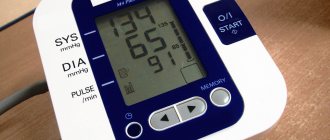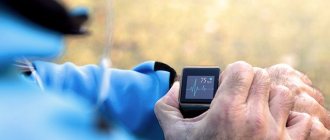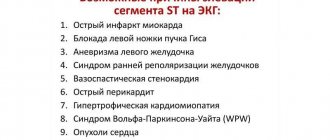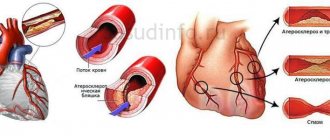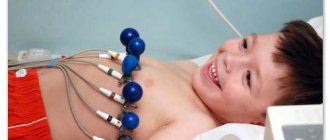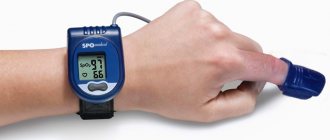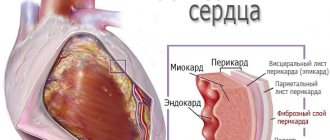Blood pressure indicators indicate the quality of the circulatory system, so ignoring these values is extremely undesirable. Control is also necessary during the period of physical activity, as the body begins to adapt to new conditions, and any violations affect the functions of internal organs.
If the pressure drops after a load, then this is a signal that cannot be left unmonitored. Under normal conditions, such a decrease should not occur, since an adequate reaction of the body involves improved blood circulation and increased activity. The reverse process indicates disorders of the cardiovascular system that need to be identified and measures taken to treat them.
Signs of low blood pressure
When training or performing heavy physical work, a tonometer is not always at hand, but even without a special device, problems with arterial indicators can be assumed. The following signs are characteristic of hypotension:
- Darkening or blurriness of the eyes. It is difficult to focus your vision.
- Dizziness, tinnitus, sensation of pulsation in the temples, especially when tilting the head.
- Weakness in the limbs.
If after physical activity the pressure drops, it is difficult not to notice this, since the person feels pre-fainting. In such cases, it is imperative to rest and not to overload the body to clarify the circumstances.
Contraindications to cardio training
There are few contraindications to exercise in pulse zone No. 1. They are determined individually. Main restrictions:
- Hypertonic disease. The danger is posed by sudden “jumps” in blood pressure. Cardio training for hypertension can be carried out only after proper correction of blood pressure.
- Coronary heart disease (myocardial infarction, angina pectoris). All loads are performed outside the acute period and only with the permission of the attending physician. Physical rehabilitation in patients with coronary artery disease has its own characteristics and deserves a separate article.
- Inflammatory heart diseases. Under a complete ban on exercise in case of endocarditis, myocarditis. Cardio training can only be done after recovery.
Tachycardia during physical activity is not just an unreasonable acceleration of heart rate. This is a complex set of adaptive physiological mechanisms.
For timely load correction and the ability to evaluate the results of cardiovascular training, I recommend keeping a diary of heart rate and blood pressure.
https://www.youtube.com/watch?v=ytadvertiseru
Author of the article: Practicing physician V. O. Chubeiko. Higher medical education (Omsk State Medical University with honors, academic degree: “Candidate of Medical Sciences”).
Causes of low blood pressure
Hypotension can appear in rare episodes when a person is simply not physically ready for such stress, but at the same time all his systems are working normally. This is why athletes choose training with a gradual increase in load. There are similar requirements for amateurs; if there is no special training, then there is no need to immediately strive for high results.
Factors not related to diseases can also affect blood pressure, for example:
- Fatigue, poor sleep.
- Hunger, dehydration.
- Hormonal changes (adolescent, drug-related, etc.).
- Lack of air in the room, high temperature.
Such causes are easily eliminated and subsequent loads pass as normal, but if attacks recur, then you need to look for the source of hypotension in your health.
In cases of frequent low blood pressure that occurs after exercise, additional diagnostic measures must be taken. The condition may worsen if the problem is ignored or if you choose medications on your own and take them to normalize the indicators.
If your blood pressure drops after training, there is a risk of developing the following diseases:
- Angina or cardiovascular dysfunction, including heart block.
- Vegetovascular dystonia. It occurs most often and is characterized as a temporary change in vascular tone. With increased tension, they partially narrow, which leads to a decrease in the blood circulation process. The reaction is not a serious pathological phenomenon and goes away on its own.
- Mitral valve prolapse. The disease occurs due to dysfunction of the valve located between the ventricle and the left atrium. If the pathology passes without complications, for example, without the development of arrhythmia or other disorders, then no special treatment is carried out.
- Chronic hypotension developing against the background of other serious diseases.
If your blood pressure drops after exercise, you don’t need to make diagnoses and take action on your own. This may be a temporary phenomenon associated with fatigue or slight malaise. Moreover, if you planned to play sports, then you don’t need to stop your endeavors, just check your health and choose the right training regimen. Even with diagnosed hypotension, there is a list of special sports that reduce the risk of attacks and have a positive effect on health and general well-being.
Why does blood pressure drop after exercise?
- The most harmless disease in which low blood pressure after exercise does not threaten life is vegetative-vascular dystonia. In this case, the lumen of the vessels does not have time to adequately adapt to the body’s requirements and a drop in pressure may occur.
- If you overheat in the sun and get heatstroke, even minor work or stress on the body can lead to a decrease in blood pressure below 90 to 60. In this case, the person turns pale, spots appear in his eyes, dizziness, and he may lose consciousness.
- Mitral valve prolapse, which often affects tall and thin young men, can also cause a drop in blood pressure even when standing up suddenly.
- A paradoxical vascular reaction is typical for patients with the initial stages of hypertension, especially if they have been involved in sports for several years before. Physical activity in such people leads to a decrease in blood pressure to normal or low numbers, while at rest they may have high blood pressure.
- More serious conditions are weakness of the sinus node and various types of bradyarrhythmias (heart block). In this case, electrical impulses from the pacemaker either do not reach at all or are significantly reduced. As a result, blood flow suffers and blood pressure may drop. Weakness of the sinus node requires surgery to establish a pacemaker, and arrhythmias require conservative treatment.
- Very low blood pressure after exercise combined with a prolonged attack of squeezing or pressing pain in the heart or behind the sternum is a sign of severe angina or myocardial infarction. In this case, you should immediately put a nitroglycerin tablet under your tongue or spray it with nitro spray and immediately call an ambulance.
Problems with blood pressure mean that you need to adhere to a certain lifestyle and limit yourself in certain things.
It is known that when playing sports, many indicators change, including blood pressure. This is not a reason to refuse physical activity - you just need to select it wisely and monitor your health. During physical activity, blood circulation accelerates sharply, therefore the flow of blood in the vascular system increases. As a result, blood pressure rises. Typically, the higher the load, the more the blood flow accelerates. In a healthy person, this process is important for the normal functioning of the body, if the permissible limits are not exceeded.
Blood pressure may also decrease during exercise, but this condition is considered abnormal and indicates serious health problems.
There is no need to avoid sports if you have low blood pressure. The correctly selected type and intensity of physical activity will not only not cause harm, but will also strengthen the cardiovascular system.
If you have low blood pressure, you can engage in the following sports:
- Jogging. It is better to start with walking, and then move on to running at a calm pace, not exceeding a speed of 7-8 km/h. Running time is increased gradually and slowly. It is effective to alternate jogging with fast walking.
- Swimming and water aerobics. This sport is good because it involves all muscle groups. While swimming, water presses on the human body. This is important for increasing the elasticity and filling of blood vessels.
- Cycling. When riding a bicycle, the leg muscles actively work, causing the blood to rise to the top. This ensures its circulation and relieves stagnation.
- Yoga. It is worth doing it individually, so that the complex is developed taking into account the characteristics of the body. For hypotensive people, evening yoga classes are especially effective.
- Dancing. There are many varieties of this sport, but with hypotension the choice is limited. You should choose dances in a calm rhythm, without sudden movements. Ballroom and oriental dancing are good.
- Pilates.
- Callanetics.
- Exercise equipment. You need to exercise in moderation, and coordinate the complexes with the trainer. Exercise bikes and treadmills are allowed (slow pace).
- Table tennis.
- Diving.
Hypotonic people should remember that when playing any sport, you need to have sweet water with you. You need to drink it little by little during breaks. It is better to do sports in the morning or evening.
For low blood pressure, physical therapy is also indicated. It can be done at any age.
With low blood pressure, physical activity should be moderate. You should start with simple exercises. The load should be increased gradually, focusing on the state of your health.
It is recommended to perform the following set of exercises:
- Walking. At first, you can limit yourself to just this or start studying with it. For the first time, a 5-minute walk is enough, then the time should be gradually increased to half an hour.
- Tilts. This exercise should be done carefully, avoiding sudden movements. You need to lean forward and to the sides. For dizziness, this exercise is contraindicated.
- Push ups. You should start with simplified exercises, push-ups from the wall or on your knees.
- Swing your legs while lying down. You need to raise your straight legs one by one, holding them in this position a little.
- Squats. First, you should use a low chair for exercise, then you can do without it, but keep the body position the same.
- Lunges forward. The back should be straight, and the front knee should be bent at a right angle. In the future, this exercise can be performed with dumbbells.
- Bike. To do this exercise, you need to lie on your back and spin imaginary pedals.
- Scissors. For the legs, this exercise is done in a lying position, for the arms - while standing.
When performing exercises, you should remember about proper breathing. It is useful to practice breathing exercises. During training, you need to breathe through your nose. The rhythm of breathing must be synchronized with the movements - all jerks are made while inhaling.
For hypotensive people, exercises that need to be done lying on the floor are good. This position should also be taken if you feel unwell or dizzy during training. In this case, you need to drink sweet water or tea.
If you have hypotension, the order of exercises must be arranged correctly. You should always start with a warm-up. Leg exercises are done at the end of the workout. Transitions should be made smoothly, warming up before each complex. For the best effect and good health, you need to exercise every day.
Hypotonic patients need to constantly monitor their blood pressure. It is imperative to take measurements before and after training to calculate the changes that have occurred. Based on this result, it is necessary to adjust the duration and intensity of sports activities.
Professionals know that it is optimal to take measurements 20 minutes before training and 10 minutes after it.
It is recommended to monitor indicators during training. It is convenient to use special fitness bracelets for this. They measure not only blood pressure, but also other indicators, such as heart rate and blood oxygen levels.
If you have low blood pressure, you should forget about most professional sports, as they mean high loads and constant training. The following sports should be excluded:
- Weightlifting;
- triathlon;
- body-building;
- powerlifting;
- some types of dancing, such as breakdancing;
- sprint, marathon running;
- sports sauna;
- motorsports;
- American football;
- struggle;
- hockey;
- figure skating;
- acrobatics.
Any sport can be played at different intensities. If you have low blood pressure or other health problems, you should consult your doctor. He will take into account the individual characteristics of the patient, determine the possibility of practicing a specific sport, and give recommendations on the intensity of the load.
In some cases, physical activity is contraindicated. This mainly applies to people whose pressure surges are pronounced and can occur without the influence of any factors. Physical activity is dangerous for heart disease, which provokes pressure changes.
Hypotension is not a reason to give up sports. It is important to choose the right direction and intensity of loads. During training, it is necessary to monitor blood pressure and other important indicators. You should choose a suitable sport taking into account the recommendations of your doctor. It is safer and more effective to exercise under the supervision of a trainer.
Low blood pressure (sometimes called arterial hypotension or simply hypotension) is essentially a decrease in tone in the muscles and blood vessels.
Low blood pressure is caused by many reasons.
For example, heart failure, chronic lack of sleep (fatigue), injuries to both the brain and spinal cord, as well as neuroses, sepsis, and so on. At the same time, it is very important to know: is it possible to play sports with low blood pressure? And if so, which one? This will be discussed now.
When the pressure is reduced, about 85% of the blood volume passes into the venous beds. This means that the arterial system (which is characterized by high pressure) accounts for only 15% of this volume.
The body is designed in such a way that the pressure of the arterial system helps blood reach all organs. And the blood flowing from these organs passes into the venous bed, where it reaches the heart and is pumped back into the arteries.
Blood pressure depends on many different factors, the main ones being:
- the volume of blood that the heart transmits per minute. This value is called the minute volume of the heart and it depends on the heart rate and the volume of the blood itself;
- from arterial resistance.
Hypotension is very multifaceted; in medicine it is usually divided into the following types:
- acute arterial. Occurs when there is a sharp drop in blood pressure. Often accompanied by acute myocardial infarction, severe arrhythmias, blood loss, allergies, and so on;
- chronic. It can occur in trained athletes and can be hereditary. But it usually does not go beyond the norm and is divided into separate types;
- chronic primary, independent disease;
- chronic secondary, occurring against the background of other diseases.
Why does blood pressure drop after exercise? Sometimes even healthy people experience drops in blood pressure after physical activity. The reasons lie in the “preventive measures” of the body.
And in this case, the body can work under load in a moderate mode of the heart and blood vessels. The course of hypotension itself is very wave-like, exacerbations and normalizations occur.
How to adjust pressure
If a person suffers from strange surges in blood pressure: he has high blood pressure or low blood pressure after physical activity, he should see a doctor and be seriously examined - all pathological situations should be under the supervision of a cardiologist. With vegetative-vascular dystonia, blood pressure fluctuations against the background of hormonal imbalances, with mild forms of hypertension, extrasystole, it is possible to take care of your health using not so much drugs, but the body’s hidden capabilities for self-regulation.
Source: https://remson58.ru/pochemu-posle-trenirovki-padaet-davlenie/
What to do with low blood pressure?
If your blood pressure drops after physical activity, you should initially stop activity and take a horizontal position. It is better to place your legs above your head, you should try to relax. If there is nausea, then it is better to lie on your side; if there is no nausea, then it is also acceptable to lie on your back. Usually after a few minutes the condition improves slightly, but you still need to lie down, as sudden movements can lead to a second attack. Sweet tea, water, and a little coffee will help you recover. If possible, fresh air should be provided.
If absolutely no improvement occurs within 5 minutes, and additional symptoms appear, for example, severe vomiting, pain behind the sternum, under the shoulder blade, then you need to call an ambulance.
Influence of physiological characteristics
Heart rate in children is initially higher than in adults. So, for a 2-year-old child in a calm state, a pulse of 115 beats per minute is considered the absolute norm. During physical activity in children, unlike adults, stroke volume (the amount of blood ejected by the heart into the vessels in one contraction), pulse and blood pressure increase more strongly.
Elderly people also have their own characteristics of heart rate readings during exercise. The deterioration of adaptive abilities is largely due to sclerotic changes in the blood vessels. Due to the fact that they become less elastic, peripheral vascular resistance increases. Unlike young people, both systolic and diastolic blood pressure are more likely to increase in old people.
There are adaptation differences depending on gender. In men, blood flow improves to a greater extent due to an increase in stroke volume and to a lesser extent due to an acceleration of heart rate. For this reason, the pulse in men is usually slightly lower (6-8 beats/min) than in women.
A person who is professionally involved in sports has significantly developed adaptive mechanisms. Bradycardia at rest is normal for him. The pulse can be below not only 60, but also 40-50 beats/min.
Improved medical advice on the role of exercise is needed
So why are we talking about an “epidemic” of hypertension? Are our doctors letting us down? Obviously, doctors can easily identify this condition: survey results from 2000 show that hypertension is the most common diagnosis during an in-person doctor's visit (total number of visits examined in the United States was 35 million).
However, we are talking about practical advice regarding exercise; doctors are clearly not doing everything in their power. What is meant here is the recommendation “You need to exercise more. I instruct you to walk 30-45 minutes a day, 5 days a week, and please start today.”
It’s sad to realize that such a conversation is a rare occurrence in medical practice. Doctors simply don't have the knowledge to give advice about exercise. It’s much easier to write out the required prescription and give a piece of paper with recommendations for yourself to review.
Maximum heart rate during physical activity
The maximum contraction frequency of the heart muscle is the number of heart beats per minute. Correct calculation will help determine the normal pulse; you need to count the artery beats for a minute. The number of these beats is your resting heart rate. Everyone has their own maximum heart rate; to determine it, you need to subtract the number of years lived from 220. For example, if a person is 30 years old, then we subtract 30 from 220, equal to 190 - this is the maximum pulse rate per minute.
Official recommendations regarding exercise for people with hypertension
Although the first evidence of the effectiveness of exercise to combat hypertension appeared back in 1973, only recently has the medical community paid attention to the very idea of recommending exercise as a means of treating certain diseases.
Until 2002-2004, there was no consensus on which means of combating hypertension were most effective. Back then the emphasis was on aerobic exercise.
In 2002, the National High Blood Pressure Education Program recommended the following: "regular aerobic physical activity, such as brisk walking, for at least 30 minutes per day on most days of the week."
In 2004, the American College of Sports Medicine (ACSM) released a recommended exercise plan for those suffering from hypertension. It included 4 elements, represented by the acronym “FITT”: frequency, intensity, time, type.
Frequency: You should train on most days of the week, ideally every day.
Intensity: Moderate exercise intensity (40-60% of VO2MAX) is recommended.
Time: The duration of classes should be at least 30 minutes per day. This can include either a single long workout or a sum of shorter periods of activity throughout the day.
Type: preference should be given to aerobic exercise, but you should not completely abandon anaerobic exercise.
If we try to convey the entire meaning of the above recommendations in one sentence, we get something like this: Walk at a fast pace for 30-45 minutes a day with a frequency of 5-7 days a week .
However, we are talking about recommendations published in 2004. As discussed above, newer research shows that resistance training is no less effective than aerobic training for people with hypertension.
This led to experts being forced to change their recommendations. Linda Pescatello was the lead author of the 2004 ACSM guidelines. And in 2020, she and her colleagues released a paper called “Exercise for People with Hypertension: Updating Recommendations to Based on the Latest Research.” This document still recommends aerobic exercise, but suggests that patients should also include anaerobic exercise 2 to 3 times per week .
Online calculator for calculating heart rate zones
| Heart rate zone (% of maximum) | Pulse (beats/minute) |
| 100% maximum heart rate | 189 |
| 90% – 100% VO2 zone | 178 – 189 |
| 80% – 90% anaerobic zone | 166 – 178 |
| 70% – 80% aerobic zone | 155 – 166 |
| 60% – 70% beginning of the fat burning zone | 143 – 155 |
| 50% – 60% light activity zone | 132 – 143 |
Vascular training program
So, how can you create a training program that does not harm the elasticity of blood vessels?
Of course, no one advises completely abandoning anaerobic training. All people, especially older people, should do resistance exercise (Read about this in our text on sarcopenia - the older you are, the more important it is to exercise). They help maintain bone density, muscle strength and size.
Here are 3 recommendations that it would be wise to follow, regardless of whether you have hypertension or not.
1. If you are only doing resistance exercises, stick to an intensity equal to 70% of your 1RM (one rep max).
Research findings suggest that when performing anaerobic exercise with heavy weights, vascular elasticity suffers. An analysis of 8 studies found that arterial elasticity actually worsened when participants performed repetitions of 70% or more of their 1RM . At the same time, more modest values of weights within 40-70% of the maximum did not cause negative changes.
The study, which included 35 elderly Korean men, found that vascular elasticity improved (albeit slightly) after resistance training. Yes, the subjects trained 5 times a week for a year, but the intensity of the training could hardly be called high: the weights were kept within 60% of the one-repetition maximum . And in general, we are talking about older people!
The American Heart Association takes an even more conservative view: people with hypertension should train with a resistance equal to 30-60% of the maximum . For example, if your maximum in the bench press is 50 kg per rep, then the working weight during training should be in the range of 15-30 kg.
2. Do not perform more than 1-2 approaches
The studies mentioned showed that resistance training at 50% of maximum still reduced vascular elasticity by 20% when performing 3 sets of each exercise . Therefore, limit yourself to 1-2 approaches, regardless of the training weight, or do not forget to perform aerobic exercises (go to point 3).
3. If you are training with a weight greater than 70% of your maximum, include aerobic exercise in your weekly training program
The study findings suggest that training at 80% of 1RM did not impair vascular elasticity when subjected to regular aerobic exercise. In one study, participants performed 3 sets with a weight of 80% of the maximum, i.e. we can say that the training program was quite intense. However, no negative effects on arterial elasticity were observed when aerobic exercise was included in the program at a frequency of 3 times per week .
People with hypertension should not avoid weight-bearing exercise. However, if you are a fan of this type of training, limit your weights to low to moderate levels. And add aerobic exercise to your training program.
In the same case, if you have hypertension and you decide to do only one type of exercise, give preference to aerobic training.
Instant Effects of Various Types of Cardiac Exercises
Obviously, a high heart rate puts significant strain on the heart. The same applies to high blood pressure.
Both aerobic and anaerobic exercise stress the heart, but this happens for different reasons: during aerobic exercise, the heart rate increases to very high values, while the blood pressure increases to a small extent .
Resistance exercise tends to have the opposite effect: a spike in blood pressure at a moderate heart rate.
To compare the two mentioned types of physical activity, the so-called frequency-pressure coefficient (i.e., heart rate X blood pressure) is sometimes used. Note that in some cases the load on the heart when performing aerobic exercises may be higher than during strength training.
